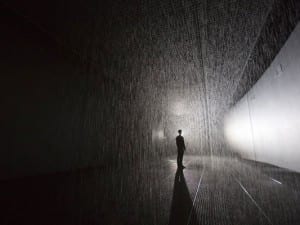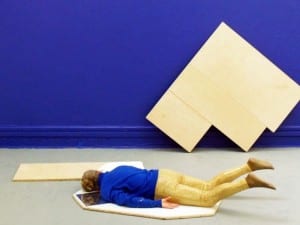The Aesthetica Art Prize is a celebration of excellence in art from across the world and offers artists the opportunity to showcase their work to wider audiences and further their involvement in the international art world. Previous finalists include Julia Vogl, who was shortlisted for New Sensations – Saatchi Gallery and Channel 4′s Prize – and has exhibited at Zabludowicz Collection; Marcus Jansen, a leading modern expressionist who joined a legacy of artists by featuring in Absolut Vodka’s artistic campaigns, and Bernat Millet, also shortlisted for National Portrait Gallery’s Taylor Wessing Photographic Portrait Prize. The 100 longlisted artists are published in the Aesthetica Art Prize Annual and the shortlisted artists will appear in an exhibition at York St Mary’s from 8 March until 28 April. We speak to long-listed artist Daniel Shiel, who uses digital photographic collage work to explore the textures and patterns in everyday objects. His entered works are Blue and Malakoff, works that result from psycho-geographical adventures into marginal and semi-abandoned areas that often lie at the edge of the urban environment and the countryside.
A: What is it that attracts you to photography?
DS: The beauty of photography is that, as the images are “captured from reality”. During the digital processing and collage work that follows on I extract specific details from photographic images, isolating them from their original context. These provide “materials” or “pallets” which I combine into fresh and unfamiliar landscapes that emphasise the essence or perspectives of my experiences. The resulting structures have a realistic and surrealist quality at the same time; they become familiar yet remote landscapes; recognisable settings, but of questionable and unsettling perspective and narrative.
I can trace my earliest interest in landscapes back to childhood holidays in Wales and Cornwall. My father would take my brother and I out on long silent walks in landscapes that sometimes bore evidence of past mining and the ruins of agricultural change. No doubt these events, which left me with palpable sensations of wonder and mystery that have remained with me to this day and led me into a career in archaeology. My professional training and career as an archaeologist puts my photographic work into context. Collecting evidence, data processing and manipulation as well as speculation and interpretation are all part of the job. However, archaeology rarely finds clear answers and most often the results of archaeological work pose many more questions than answers
I take this enjoyment of exploring and speculating with me on my psycho-geographical adventures documented with my camera. My fascination with speculation goes wherever I go, simple walks become adventures full of wonder and mystery and it is this that I hope to explore and communicate in my art work.
A: Do you work with any other artistic forms?
DS: As I feel that I have hardly explored the possibilities of photography, I’ve not worked with any other artistic forms as yet. When I’m exploring with my camera, I feel that I’m working in a less frequented area of expression in terms of materials and approach; I believe there is plenty of room here for me to explore.
Although I’m interested in the “mainstream” of photography, I don’t feel competent or have any desire to compete in the traditional fields of photography. However, my lack of technical know how draws me toward improving my technique.
Perhaps for me, and my artistic expression, this is the right and natural way around. “Find what it is you want to do, try doing it and then learn how to improve and develop the results”, rather than, “learn how to use a camera and then find what to photograph”.
The use of various other technologies, such as pinhole cameras, print making methods and reproduction techniques would be an interesting way to explore the practicalities of photography.
One way in which I would like to continue my speculations is in writing. I’ve written a number of short stories of varying sorts and these relate to my explorations and wonderment at places and things that on the surface are everyday and overlooked. I’ve really enjoyed expanding a simple thought, exploring its possibilities and running with an idea at speed in an uncertain direction. A series of stories centred on the village in Yorkshire in which I lived were great fun to do; fulfilling a need to put down crazy ideas gong around in my head. The results, so far unpublished, are similarly surreal.
A: How does it feel to be part of the Aesthetica Art Prize?
DS: I’ve enjoyed taking part in the Aesthetica Art Prize for a number of reasons. As an artist, I don’t so much wonder why I do my work, I enjoy it immensely. However, I do wonder at what I’m actually doing and whether it’s of interest to anyone else; like many artists, I work largely alone.
I’ve my work in several galleries and I like to take part in art market events because one gets direct involvement from all kinds of people who, on the whole, are interested and entertained. I’m surprised at the appeal of my work; it’s a great buzz.
The Aesthetica Art Prize though is a bit different. It offers the opportunity for my work to be seen and assessed by other artists and professionals in the art world. Having reached the long list is a great boost for me. I’ve had my work looked at and appraised and I feel that I am doing something of interest. It’s invaluable encouragement. It fulfils a desire to show the work and share the fascination, wonder and mystery I find and explore with my camera.
I’m very much looking forward to visiting York St Mary’s and feeling the pleasure of being involved in such an event and in such a beautiful place; a place I’ve enjoyed before as a visitor. It’s a great location.
Taking part in a contest of this kind is enjoyable. Preparing the work and gathering together the documentation and sending it on its way builds a tension and excitement. Speculation – that word again – on the likelihood of success; how will I feel about the results? In fact I had just been selected to show my work in Cork Street, London. So being selected for Aesthetica Art Prize long list was the icing on the cake; a great end to a good year for developing my art practice.
A: Which photographers have inspired you?
DS: I do enjoy looking at photography and I admire the work of documentary photographers in particular. But I would not describe myself as a photographer, so I don’t tend to seek inspiration from photographers.
On the other hand I have been inspired by the work of Edward Hopper. I’m drawn to the tension and atmosphere expressed in his work. There are strong sensations of loneliness, isolation, misunderstanding and communication failure. Despite the emptiness of the architectural spaces in some in some of his subjects there is a sense of restlessness present that is utterly absorbing. One cannot help but to be drawn in to his pieces and contemplate about the drama that is about to unfold or has just happened. I feel that I’m aiming for something of the same in my photographic work.
A: What do you have planned for the future?
DS: Until recently, I have concentrated on composition and subject; collecting the “materials” and “pallets” for my collage pieces. I hope in the first instance to become more proficient with my camera; learning more about technique, improving it and experimenting with it.
I’d also like to move my collage work into 3D or at least into “2-and-a-bit-D”. I’m thinking about building the images up in layers, giving the pieces more depth and, hopefully, develop the atmosphere, deepen the impression. This will, I suppose, move my work away from pure image processing and manipulation toward a kind of sculpture. I have been wondering about increasing the size of the works and wondering about the effects of 1:1 scaling of production; something for the far future perhaps.
I’ve also been considering how to take my work from the largely urban setting into the countryside, combining images into landscapes using the gradation of shades in black and white to create distance and depth and using silhouette.
I’m always thinking of ways to get my work out and on view. As yet I’ve not exploited online galleries and intend to investigate the wide possibilities they offer; digital art is obviously ideally suited to this.
A: What was the first photo you took?
DS: I can’t remember taking my first photograph. They would have been holiday snaps and family photos. I do remember the photos I took that started me down the route of using photography for artistic expression. I was working in a small village somewhere in Suffolk. Arriving at the site we discovered that it was overgrown and we couldn’t proceed without the field being mown. So we waited in a farmyard of ramshackle corrugated iron sheds for the farmer to come. It was a sunny warm day and I was drawn to the way the sun reflected off the hot rusty corrugated iron. Also, the way the convolutions played shadows over the surfaces. The iron had been painted several times, was patched and full of holes, which was magical, and I began to photograph. Showing the results to friends, they thought I’d finally flipped. Some, however, had a look at corrugated iron for themselves and confidentially told me that they could see where I was coming from. That was quite a number of years ago but I can remember that day well and I suppose it has meant a great deal to me. I recaptured thoughts and sensations that I’d had as a child.
Aesthetica Art Prize Exhibition, 8 March – 28 April, York St Mary’s, York.
Credits
Images courtesy of Daniel Shiel and Aesthetica.
1. Malakoff
2. Blue




